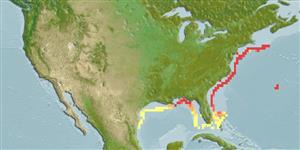Environment: milieu / climate zone / depth range / distribution range
Ekologi
marina bottenlevande; djupintervall 106 - 154 m (Ref. 86730). Subtropical; 41°N - 24°N
Western Atlantic: New Jersey to southern Florida in the USA; more northern records are based on misidentifications. Northwest Atlantic: Canada (Ref. 5951).
Size / Vikt / Age
Maturity: Lm ? range ? - ? cm
Max length : 46.7 cm TL hane/ej könsbestämd; (Ref. 40865)
Inhabits offshore water (Ref. 7251). Males mature at 19.7 cm TL and females gravid at 22.7 cm TL (Ref. 40865).
Life cycle and mating behavior
Maturities | Reproduktion | Spawnings | Egg(s) | Fecundities | Larver
Robins, C.R. and G.C. Ray, 1986. A field guide to Atlantic coast fishes of North America. Houghton Mifflin Company, Boston, U.S.A. 354 p. (Ref. 7251)
IUCN Red List Status (Ref. 130435)
Threat to humans
Harmless
Human uses
Fiskeri: saknar intresse
Verktyg
Special reports
Download XML
Internet-källor
Estimates based on models
Preferred temperature (Ref.
123201): 11.5 - 22.2, mean 18 °C (based on 9 cells).
Phylogenetic diversity index (Ref.
82804): PD
50 = 0.5000 [Uniqueness, from 0.5 = low to 2.0 = high].
Bayesian length-weight: a=0.00089 (0.00039 - 0.00204), b=3.00 (2.80 - 3.20), in cm total length, based on LWR estimates for this (Sub)family-body shape (Ref.
93245).
Trofisk nivå (Ref.
69278): 3.4 ±0.0 se; based on diet studies.
Resiliens (Ref.
120179): Hög, lägsta populationsfördubblingstid mindre än 15 månader (Preliminary K or Fecundity.).
Fishing Vulnerability (Ref.
59153): Moderate vulnerability (37 of 100).
